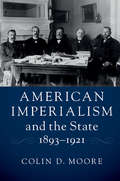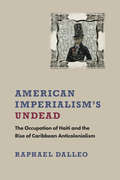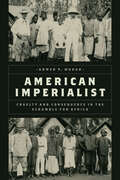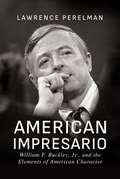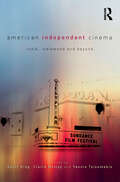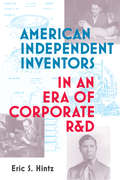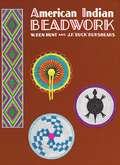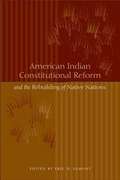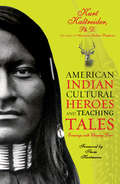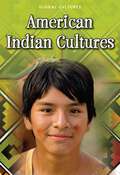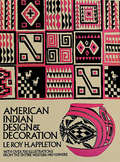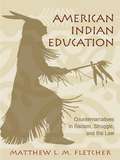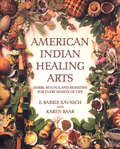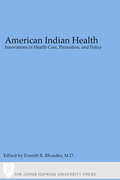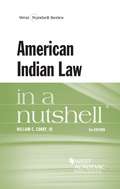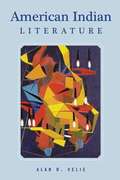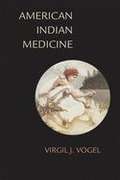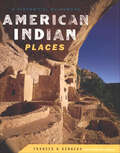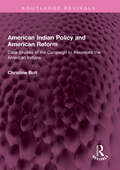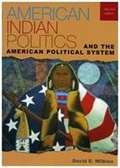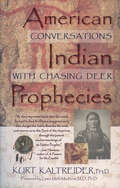- Table View
- List View
American Imperialism and the State, 1893–1921
by Moore Colin D.How did the acquisition of overseas colonies affect the development of the American state? How did the constitutional system shape the expansion and governance of American empire? American Imperialism and the State offers a new perspective on these questions by recasting American imperial governance as an episode of state building. Colin D. Moore argues that the empire was decisively shaped by the efforts of colonial state officials to achieve greater autonomy in the face of congressional obstruction, public indifference and limitations on administrative capacity. Drawing on extensive archival research, the book focuses principally upon four cases of imperial governance - Hawai'i, the Philippines, the Dominican Republic and Haiti - to highlight the essential tension between American mass democracy and imperial expansion.
American Imperialism's Undead: The Occupation of Haiti and the Rise of Caribbean Anticolonialism (New World Studies)
by Raphael DalleoAs modern Caribbean politics and literature emerged in the first half of the twentieth century, Haiti, as the region's first independent state, stood as a source of inspiration for imagining decolonization and rooting regional identity in Africanness. Yet at precisely the same moment that anticolonialism was spreading throughout the Caribbean, Haiti itself was occupied by U.S. marines, a fact that regional political and cultural histories too often overlook. In American Imperialism's Undead, Raphael Dalleo examines how Caribbean literature and activism emerged in the shadow of the U.S. military occupation of Haiti (1915-34) and how that presence influenced the development of anticolonialism throughout the region. The occupation was a generative event for Caribbean activists such as C. L. R. James, George Padmore, and Marcus and Amy Jacques Garvey as well as for writers such as Claude McKay, Eric Walrond, and Alejo Carpentier. Dalleo provides new ways of understanding these luminaries, while also showing how other important figures such as Aimé Césaire, Arturo Schomburg, Claudia Jones, Frantz Fanon, Amy Ashwood Garvey, H. G. De Lisser, Luis Palés Matos, George Lamming, and Jean Rhys can be contextualized in terms of the occupation. By examining Caribbean responses to Haiti's occupation, Dalleo underscores U.S. imperialism as a crucial if unspoken influence on anticolonial discourses and decolonization in the region. Without acknowledging the significance of the occupation of Haiti, our understanding of Atlantic history cannot be complete.
American Imperialist: Cruelty and Consequence in the Scramble for Africa
by Arwen P. MohunThis biography of “African explorer” Richard Dorsey Mohun, written by one of his descendants, reveals how American greed and state power helped shape the new imperial order in Africa. Richard Dorsey Mohun spent his career circulating among the eastern United States, the cities and courts of Europe, and the African continent, as he served the US State Department at some points and King Leopold of Belgium at others. A freelance imperialist, he implemented the schemes of American investors and the Congo Free State alike. Without men like him, Africa’s history might have unfolded very differently. How did an ordinary son of a Washington bookseller become the agent of American corporate greed and European imperial ambition? Why did he choose to act in ways that ranged from thoughtless and amoral to criminal and unforgivable? With unblinking clarity and precision, historian Arwen P. Mohun interrogates the life and actions of her great-grandfather in American Imperialist. She seeks not to excuse the man known as Dorsey but to understand how individual ambition and imperial lust fueled each other, to catastrophic ends. Ultimately, she offers a nuanced portrait of how her great-grandfather’s pursuit of career success and financial security for his family came at a tragic cost to countless Africans.
American Impresario: William F. Buckley, Jr., and the Elements of American Character
by Lawrence PerelmanIn 1994, William F. Buckley, Jr., the conservative icon, received a letter from an eighteen-year-old aspiring pianist by the name of Lawrence Perelman, the son of Soviet Jewish immigrants. Buckley&’s response sparked a remarkable cross-generational friendship during which Perelman learned of the timeless elements of Buckley&’s character, and the central role of classical music in Buckley&’s American vision.Lawrence Perelman, an eighteen-year-old aspiring pianist and son of Soviet Jewish immigrants, wrote a letter to William F. Buckley, Jr., the conservative icon, in 1994. A remarkable cross-generational friendship was sparked by Buckley&’s response. During their friendship Perelman would go on to learn of the timeless elements of Buckley&’s character and the central role of classical music in Buckley&’s American vision. In 2025, the 100th anniversary of Buckley&’s birth, this book delves into some of Buckley&’s virtues which Perelman witnessed firsthand and argues that those virtues can transform the fabric of America&’s character. Their friendship spanned from 1995 to February 27, 2008, the day Buckley passed away in his Connecticut home while Perelman practiced piano in a nearby room for a private recital that evening for Buckley and friends that would never happen. American Impresario is a portrait of Buckley, the impresario of the conservative movement, man of faith, Cold Warrior, bulwark against Anti-Semitism, Renaissance man, musician, and mentor to countless people who continue their work today. This book will inspire readers, both young and old, to emulate Buckley&’s virtues, including a return to civil discourse, anonymous philanthropy, faith, patriotism and fostering relationships between mentor and protégé, as part of a goal to reweave the fabric of our nation&’s character.
American Independent Cinema: indie, indiewood and beyond
by Yannis Tzioumakis Claire Molloy Geoff KingThe American independent sector has attracted much attention in recent years, an upsurge of academic work on the subject being accompanied by wider public debate. But many questions remain about how exactly independence should be defined and how its relationship might be understood with other parts of the cinematic landscape, most notably the Hollywood studios. Edited and written by leading authors in the field, American Independent Cinema: indie, indiewood and beyond offers an examination of the field through four sections that range in focus from broad definitions to close focus on particular manifestations of independence. A wide variety of examples are included but within a framework that offers insights into how these are related to one another. More specifically this collection offers: an account of recent developments as well as reviewing, reassessing and revising a number of central positions, approaches and arguments relating to various parts of the independent and/or indie sector. Individual case studies that range from the distinctive qualities of the work of established ‘quality’ filmmakers such as Wes Anderson, Steven Soderbergh and Rebecca Miller to studies of horror genre production at the more ‘disreputable’ end of the independent spectrum. Examples of the limits of independence available in some cases within Hollywood, including studies of the work of Stanley Kubrick and Hal Ashby. Case studies of under-researched areas in the margins of American independent cinema, including the Disney nature films and Christian evangelical filmmaking. A number of wider overview chapters that examine contemporary American independent cinema from a number of perspectives. Together, the chapters in the collection offer a unique contribution to the study of independent film in the United States. Contributors: Warren Buckland, Philip Drake, Mark Gallagher, Geoff King, Peter Krämer, Novotny Lawrence, James MacDowell, Claire Molloy, Michael Z. Newman, Alisa Perren, James Russell, Thomas Schatz, Michele Schreiber, Janet Staiger, Yannis Tzioumakis, Sarah Wharton
American Independent Inventors in an Era of Corporate R&D (Lemelson Center Studies in Invention and Innovation series)
by Eric S. HintzHow America's individual inventors persisted alongside corporate R&D labs as an important source of inventions.During the nineteenth century, heroic individual inventors such as Thomas Edison and Alexander Graham Bell created entirely new industries while achieving widespread fame. However, by 1927, a New York Times editorial suggested that teams of corporate scientists at General Electric, AT&T, and DuPont had replaced the solitary "garret inventor" as the wellspring of invention. But these inventors never disappeared. In this book, Eric Hintz argues that lesser-known inventors such as Chester Carlson (Xerox photocopier), Samuel Ruben (Duracell batteries), and Earl Tupper (Tupperware) continued to develop important technologies throughout the twentieth century. Moreover, Hintz explains how independent inventors gradually fell from public view as corporate brands increasingly became associated with high-tech innovation.Focusing on the years from 1890 to 1950, Hintz documents how American independent inventors competed (and sometimes partnered) with their corporate rivals, adopted a variety of flexible commercialization strategies, established a series of short-lived professional groups, lobbied for fairer patent laws, and mobilized for two world wars. After 1950, the experiences of independent inventors generally mirrored the patterns of their predecessors, and they continued to be overshadowed during corporate R&D's postwar golden age. The independents enjoyed a resurgence, however, at the turn of the twenty-first century, as Apple's Steve Jobs and Shark Tank's Lori Greiner heralded a new generation of heroic inventor-entrepreneurs. By recovering the stories of a group once considered extinct, Hintz shows that independent inventors have long been—and remain—an important source of new technologies.
American Indian / First Nations Schooling
by Charles L. GlennTracing the history of Native American schooling in North America, this book emphasizes factors in society at large - and sometimes within indigenous communities - which led to Native American children being separate from the white majority. Charles L. Glenn examines the evolving assumptions about race and culture as applied to schooling, the reactions of parents and tribal leadership in the United States and Canada, and the symbolic as well as practical role of indigenous languages and of efforts to maintain them.
American Indian Beadwork
by W. Ben Hunt J.F. "Buck" BurshearsOne of the original classical books on Indian beadwork art. Includes detailed directions for various beading stitches as well as making and stringing a loom.
American Indian Constitutional Reform and the Rebuilding of Native Nations
by Eric D. LemontSince 1975, when the U.S. government adopted a policy of self-determination for American Indian nations, a large number of the 562 federally recognized nations have seized the opportunity to govern themselves and determine their own economic, political, and cultural futures. As a first and crucial step in this process, many nations are revising constitutions originally developed by the U.S. government to create governmental structures more attuned to native people's unique cultural and political values. These new constitutions and the governing institutions they create are fostering greater governmental stability and accountability, increasing citizen support of government, and providing a firmer foundation for economic and political development. This book brings together for the first time the writings of tribal reform leaders, academics, and legal practitioners to offer a comprehensive overview of American Indian nations' constitutional reform processes and the rebuilding of native nations. The book is organized in three sections. The first part investigates the historical, cultural, economic, and political motivations behind American Indian nations' recent reform efforts. The second part examines the most significant areas of reform, including criteria for tribal membership/citizenship and the reform of governmental institutions. The book concludes with a discussion of how American Indian nations are navigating the process of reform, including overcoming the politics of reform, maximizing citizen participation, and developing short-term and long-term programs of civic education.
American Indian Cultural Heroes and Teaching Tales: Evenings With Chasing Deer
by Kurt KaltreiderThe first section of this books tells the tales of three great figures in American Indian culture: two of flesh and bone and one heroine of spirit. These stories give us hope that in a time of disaray and despair, a culture can be turned around to walk a more wholesome path. The second section offers yarns from the Lakota that relate the dire consequences in store for those who choose to live a life of self-centered pursuit. In all of them, we're reminded that only a life lived in integrity and service is a life worth living.
American Indian Design and Decoration
by Le Roy AppletonThe most original and most powerful design art produced in the Western Hemisphere is also its most indigenous: that of the Indian, in innumerable cultures existing from prehistory to the arrival of the white man, reaching from the Arctic Circle to Tierra del Fuego. It owes, of course, nothing to Europe or the classical Orient. It is tremendous in variety, differing region by region, era by era, often tribe by tribe. It is always vigorously distinctive. This book, 20 years in preparation, shows us that art in all its profuse diversity and in the almost numberless crafts for which the American Indian is famous. Well over 700 examples, drawn with painstaking care, are shown: representations of flora and fauna, men and gods, earth and sky; symbols of clan and tribe, religion and magic; formal designs from the primal to the highly intricate. They appear in examples of basketry, weaving, pottery, sculpture, painting, lapidary work, masks, drumheads, weapons, apparel, beadwork, goldwork, blankets, ponchos, and many other forms. The arts and crafts of Inca, Tiahuanaco, Chimú, Maya, Axtec, Zapotec, Totonac, Mixtec, Navaho, Zuni, Hopi, Apache, Cherokee, Creek, Winnebago, Dakota, Blackfoot, Nez Percé, Cheyenne, Crow, Sioux, Cochiti, Haida, Bellacoola, and others known and unknown are here. Each section is preceded by a page of typical motifs of an area, making it easy to isolate the design elements. In addition, the lore and tradition behind the designs are told in a text reproducing the Indians' own stories and songs. Separate indices simplify locating the work of particular tribes and regions. Craftspeople will find in this book a prolific source of timeless, eternally valid design ideas representing years of research in museums all over the hemisphere; for the graphic artist there is a wealth of material than can be adapted directly to his needs. All those interested in the Americans who preceded us on these continents will find this work unique.
American Indian Education: Counternarratives in Racism, Struggle, and the Law
by Matthew L. FletcherAmerica Indian culture and traditions have survived an unusual amount of oppressive federal and state educational policies intended to assimilate Indian people and destroy their cultures and languages. Yet, Indian culture, traditions, and people often continue to be treated as objects in the classroom and in the curriculum. Using a critical race theory framework and a unique "counternarrative" methodology, American Indian Education explores a host of modern educational issues facing American Indian peoples—from the impact of Indian sports mascots on students and communities, to the uses and abuses of law that often never reach a courtroom, and the intergenerational impacts of American Indian education policy on Indian children today. By interweaving empirical research with accessible composite narratives, Matthew Fletcher breaches the gap between solid educational policy and the on-the-ground reality of Indian students, highlighting the challenges faced by American Indian students and paving the way for an honest discussion about solutions.
American Indian Healing Arts
by E. Barrie KavaschAmerican Indian Healing Arts is a magical blend of plant lore, history, and living tradition that draws on a lifetime of study with native healers by herbalist and ethnobotanist E. Barrie Kavasch. Here are the time-honored tribal rituals performed to promote good health, heal illness, and bring mind and spirit into harmony with nature. Here also are dozens of safe, effective earth remedies--many of which are now being confirmed by modern research. Each chapter introduces a new stage in the life cycle, from the delightful Navajo First Smile Ceremony (welcoming a new baby) to the Apache Sunrise Ceremony (celebrating puberty) to the Seminole Old People's Dance. At the heart of the book are more than sixty easy-to-use herbal remedies--including soothing rubs for baby, a yucca face mask for troubled skin, relaxing teas, massage oils, natural insect repellents, and fragrant smudge sticks. There are also guidelines for assembling a basic American Indian medicine chest.
American Indian Health: Innovations in Health Care, Promotion, and Policy
by Everett R. RhoadesDisease processes among American Indians and Alaska Natives often have distinct manifestations that need to be considered by clinicians and health policy makers involved with these populations. Equally important, all aspects of Indian life—including health—are governed by the special relationship between Indian tribes and the U.S. federal government. For American Indian Health, Everett R. Rhoades has gathered a distinguished group of scholars and practitioners to present a comprehensive assessment of the health of American Indian peoples today and the delivery of health services to them.
American Indian Law in a Nutshell, 6th Edition
by William C. CanbyThis guide provides a reliable resource on American Indian law. The text covers the essentials of this complex body of law, with attention to the governmental policies underlying it. The work emphasizes both the historical development of Federal Indian Law and recent matters such as the evolution of Indian gaming, issues arising under the Indian Child Welfare Act, and the present enforcement of treaty rights.
American Indian Literature: An Anthology
by Alan R. VelieThe first section of this anthology contains English retellings of songs and narratives from the oral traditions of many tribes. The second half comprises poetry and novel excerpts from contemporary Native American writers, such as Louise Erdrich and N. Scott Momaday.
American Indian Medicine (The Civilization of the American Indian #95)
by Virgil J. VogelThe purpose of this book, says the author, is to show the effect of Indian medicinal practices on white civilization. It discusses Indian theories of disease and methods of combating disease and even goes into the question of which diseases were indigenous and which were brought to the Indian by the white man. It also lists Indian drugs that have won acceptance in the Pharmacopeia of the United States and the National Formulary.
American Indian Myths and Legends
by Richard Erdoes Alfonso OrtizGathering 160 tales from 80 tribal groups to offer a rich and lively panorama of the Native American mythic heritage. 100 drawings.
American Indian Persistence and Resurgence
by Karl KroeberThis collection celebrates the resurgence of Native Americans within the cultural landscape of the United States. During the past quarter century, the Native American population in the United States has seen an astonishing demographic growth reaching beyond all biological probability as increasing numbers of Americans desire to admit or to claim Native American ancestry. This volume illustrates a unique moment in history, as unprecedented numbers of Native Americans seek to create a powerful, flexible sense of cultural identity.Diverse commentators, including literary critics, anthropologists, ethnohistorians, poets and a novelist address persistent issues facing Native Americans and Native American studies today. The future of White-Indian relation, the viability of Pan-Indianism, tensions between Native Americans and North American anthropologists, and new devlopments in ethnohistory are among the topics discussed. The survival of Native Americans as recorded in this collection, an expanded edition of a special issue of boundary 2, brings into focus the dynamically adaptive values of Native American culture. Native Americans' persistence in U.S. culture--not disappearing under the pressure to assimilate or through genocidal warfare--reminds us of the extent to which any living culture is defined by the process of transformation.Contributors. Linda Ainsworth, Jonathan Boyarin, Raymomd J. DeMallie, Elaine Jahner, Karl Kroeber, William Overstreet, Douglas R. Parks, Katharine Pearce, Jarold Ramsey, Wendy Rose, Edward H. Spicer, Gerald Vizenor, Priscilla Wald
American Indian Places: A Historical Guidebook
by Frances H. KennedyThis historical guidebook includes 366 places that are significant to American Indians and open to the public. The book is organized geographically and includes location information, maps, and color photographs as well as suggestions for further reading about the sites and an extensive bibliography.Among the 279 authorities who know and revere these places and have written essays on them and on topics relating to them are William deBuys, Suzan Shown Harjo, Frederick E. Hoxie, Clara Sue Kidwell, Malinda Maynor Lowery, Rennard Strickland, and David Hurst Thomas. Tribal culture committees and tribal historians also contributed essays. Frances H. Kennedy, the editor and principal contributor, has written short entries on more than a hundred of the places.The places covered in the book include: Ganondagan State Historic Site in New York Kituhwa Mound in North Carolina, Cahokia Mounds State Historic Site in Illinois, Crystal River Archaeological State Park in Florida, Effigy Mounds National Monument in Iowa, Devils Tower National Monument in Wyoming, Chaco Culture National Historical Park in New Mexico, Navajo National Monument in Arizona, Olompali State Historic Park in California, La Purisima Mission State Historic Park in California, Nez Perce National Historical Park in Idaho.
American Indian Policy and American Reform: Case Studies of the Campaign to Assimilate the American Indians (Routledge Revivals)
by Christine BoltFirst published in 1987, American Indian Policy and American Reform examines key aspects of American Indian policy and reform in the context of American ethnic problems and traditions of reform. The first four chapters provide a chronological survey discussing racial attitudes, economic issues, the role of the Bureau of Indian Affairs, missionary and reformer involvement with government policy, the political interaction of Indians and whites, and other continuing differences between the two races. The second part of the book examines important themes which illuminate the difficulties of the assimilation campaign. In a series of case studies, Prof. Bolt explores Indian-black-white relations in the South and Indian Territory, American anthropologists and American Indians, Indian education from colonial times to the 20th century, Indian women, urban Indians since the Second World War and Indian political protest groups. This book will be of interest to students of American history, ‘minority’ history and race relations.
American Indian Policy in the Twentieth Century
by Vine Deloria Jr.A paperback reprint of the important collection of essays on federal Indian policy originally published in 1985 by the U. of Oklahoma Press.
American Indian Politics and the American Political System (2nd edition)
by David E. WilkinsIn this college textbook, Wilkins (American Indian studies, political science, law, and American studies, U. of Minnesota) considers the relationship of American Indian governments to the American political system with emphasis on the sovereignty of tribal nations. He analyzes the status of indigenous peoples and their citizenship, the concept of tribal sovereignty and the issues policymakers have, and their relationship with the government's branches. He provides an overview of federal Indian policy in history, descriptions of tribal governments, political economy and gaming, participation, interest-group activities and social activism, and the effect of the media. This edition integrates new census data; discussions of changes to elections, US House and Senate personnel, and legislation on Indian rights and the state-tribal relationship; and information on George W. Bush's terms in office. Annotation ©2006 Book News, Inc., Portland, OR (booknews.com)
American Indian Prophecies: Conversations With Chasing Deer
by Kurt KaltreiderAmerican Indian Prophecies: Conversations with Chasing Deer tells of indigenous American culture, values, and spirituality as seen through their prophecies. The book is a series of conversations between young John Peabody of the New England gentry and Chasing Deer, an aged Cheyenne/Lakota and keeper of the true history of the Americas. As the conversations unfold, you see the contrast between Euro-American and American Indian cultures and values, bringing many interesting questions to light. As the conversations unfold, we learn that perhaps the Amercian Indian culture has some of the answers that we are all looking for.
